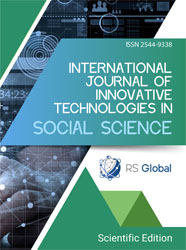THE POPULATION OF MILA FACING THE EARTHQUAKE OF AUGUST 07, 2020
Abstract
The surge in urbanization within regions vulnerable to seismic activity poses a significant escalation in seismic risks. Effective mitigation strategies, reliant on improved architectural practices and behavioral adaptations, are imperative to curtail the toll of seismic events. Seismic vulnerability, intricately intertwined with seismic hazard, building conditions, and populace preparedness, underscores the need for comprehensive risk assessment. Although studies elucidating seismic risk knowledge and behaviors are scant in Algeria, they are more prevalent in Mediterranean regions. This paper delves into the examination of risk culture, discerning both direct and indirect causative factors behind the seismic disaster that befell Mila on August 7, 2020.Employing a research methodology that integrates the method Did You Feel It (DYFI USGS ) with a survey model used in Beirut, Lebanon.The findings offer notable insights for two principal reasons. Firstly, local perceptions of the seismic event's severity surpassed estimates by the US Geological Survey (USGS). Secondly, despite the relatively minor magnitude of seismic effects in the El Kherba neighborhood, the populace displayed inadequate preparedness for future earthquakes. Additionally, site-specific factors exerted substantial influence on crisis outcomes. In this context, the preparedness of Algerian society for seismic risks depends on understanding the phenomenon, recognizing associated hazards, and identifying available resources.
Contribution: this study serves as a pivotal resource for fostering proactive local population preparedness and mitigating natural risks. Furthermore, it seeks to augment the efficacy of policies aimed at managing natural disaster risks in Algeria.
References
Beck, Elise, Stéphane Cartier, Ludvina Colbeau-Justin, Carine Azzam, and Maud Saikali. 2019. ‘Vulnerability to Earthquake of Beirut Residents (Lebanon): Perception, Knowledge, and Protection Strategies’. Journal of Risk Research 22 (11): 1391–1408. https://doi.org/10.1080/13669877.2018.1466826.
Beck, Ulrich, Laure Bernardi, and Bruno Latour. 2008. La société du risque: sur la voie d’une autre modernité. Champs. Paris: Flammarion.
Benitez, Fanny, Magali Reghezza-Zitt, and Nancy Meschinet de Richemond. 2020. ‘Culture Du Risque Cyclonique et Résilience Individuelle En Guadeloupe et à Saint-Martin’. EchoGéo, no. 51 (April). https://doi.org/10.4000/echogeo.18567.
Blesius, Jean-Christophe. 2013. ‘Discours Sur La Culture Du Risque, Entre Approches Négative et Positive. Vers Une Éducation Aux Risques ?: Étude Comparée Du Québec et de La France’. Géographie et Cultures, no. 88 (December): 249–65. https://doi.org/10.4000/gc.3141.
Boukri, Mehdi, Mohammed Naboussi Farsi, Ahmed Mebarki, and Mohamed Belazougui. 2013. ‘Development of an Integrated Approach for Algerian Building Seismic Damage Assessment’. Structural Engineering and Mechanics 47 (4): 471–93. https://doi.org/10.12989/SEM.2013.47.4.471.
Bounemeur, Nadira, Riad Benzaid, Hassiba Kherrouba, and Souad Atoub. 2022. ‘Landslides in Mila Town (Northeast Algeria): Causes and Consequences’. Arabian Journal of Geosciences 15 (8): 753. https://doi.org/10.1007/s12517-022-09959-7.
Cartier, Stéphane. 2004. ‘Conditions Sociales de La Prévention Du Risque Sismique à Boumerdès’. Algérie, IRD, Sciences Au Sud. 2004.
CGS. 2020. ‘SEISME DE MILA DU 07/08/2020 (Mw=4.9) Aspects Sismologique et Géotechnique’. Alger.
Cutter, Susan L. 2012. Hazards Vulnerability and Environmental Justice. Routledge.
Cutter, Susan L., Lindsey Barnes, Melissa Berry, Christopher Burton, Elijah Evans, Eric Tate, and Jennifer Webb. 2008. ‘A Place-Based Model for Understanding Community Resilience to Natural Disasters’. Global Environmental Change 18 (4): 598–606. https://doi.org/10.1016/j.gloenvcha.2008.07.013.
Defossez, Stéphanie, Frédéric Leone, Clément Dompnier, Mélanie André, Jean-Philippe Cherel, and Nicolas Taillefer. 2023. ‘À l’épreuve du séisme du 11 novembre 2019 (Le Teil, France) : de l’impact au relèvement territorial’. Géocarrefour 97 (3). https://doi.org/10.4000/geocarrefour.22168.
Fabiani, Jean-Louis, and Jacques Theys, eds. 1987. La Société Vulnérable: Évaluer et Maîtriser Les Risques. Paris: Presses de l’Ecole normale supérieure.
Gaillard, J.C. 2010. ‘Vulnerability, Capacity and Resilience: Perspectives for Climate and Development Policy’. Journal of International Development 22 (2): 218–32. https://doi.org/10.1002/jid.1675.
Gallopín, Gilberto C. 2006. ‘Linkages between Vulnerability, Resilience, and Adaptive Capacity’. Global Environmental Change 16 (3): 293–303. https://doi.org/10.1016/j.gloenvcha.2006.02.004.
Goltz, James D, Hyejeong Park, Genta Nakano, and Katsuya Yamori. 2020. ‘Earthquake Ground Motion and Human Behavior: Using DYFI Data to Assess Behavioral Response to Earthquakes’. Earthquake Spectra 36 (3): 1231–53. https://doi.org/10.1177/8755293019899958.
Mouloud, Hamidatou, Amar Chaker, Hallal Nassim, Saad Lebdioui, Hugo Rodrigues, and Matthew R. Agius. 2023. ‘Post-Earthquake Damage Classification and Assessment: Case Study of the Residential Buildings after the Mw = 5 Earthquake in Mila City, Northeast Algeria on August 7, 2020’. Bulletin of Earthquake Engineering 21 (2): 849–91. https://doi.org/10.1007/s10518-022-01568-9.
Pérouse De Montclos, Marc-Antoine. 2006. ‘De l’impartialité Des Humanitaires et de Leur Perception Par Les Bénéficiaires : Les Enjeux Politiques de l’aide Internationale Au Burundi:’ Autrepart n° 39 (3): 39–57. https://doi.org/10.3917/autr.039.0039.
Slovic, Paul. 1987. ‘Perception of Risk’. Science 236 (4799): 280–85. https://doi.org/10.1126/science.3563507.
Smith, Susan M., Mary Jane Tremethick, Peggy Johnson, and June Gorski. 2009. ‘Disaster Planning and Response: Considering the Needs of the Frail Elderly’. International Journal of Emergency Management 6 (1): 1–13.
Thouret, Jean-Claude, and Robert D’ercole. 1996. ‘Vulnérabilité Aux Risques Naturels En Milieu Urbain: Effets, Facteurs et Réponses Sociales’. Cahiers Des Sciences Humaines. ORSTOM 32 (2): 407–22.
Weichselgartner, Juergen, and Ilan Kelman. 2015. ‘Geographies of Resilience: Challenges and Opportunities of a Descriptive Concept’. Progress in Human Geography 39 (3): 249–67. https://doi.org/10.1177/0309132513518834.
Wisner, Ben, Piers Blaikie, Terry Cannon, and Ian Davis. 2003. At Risk: Natural Hazards, People’s Vulnerability and Disasters. 2nd edition. London ; New York: Routledge.
Wisner, Benjamin. 2016. ‘Vulnerability as Concept, Model, Metric, and Tool’. In Oxford Research Encyclopedia of Natural Hazard Science, by Benjamin Wisner. Oxford University Press. https://doi.org/10.1093/acrefore/9780199389407.013.25.
Views:
105
Downloads:
54
Copyright (c) 2024 Farida Sehili

This work is licensed under a Creative Commons Attribution 4.0 International License.
All articles are published in open-access and licensed under a Creative Commons Attribution 4.0 International License (CC BY 4.0). Hence, authors retain copyright to the content of the articles.
CC BY 4.0 License allows content to be copied, adapted, displayed, distributed, re-published or otherwise re-used for any purpose including for adaptation and commercial use provided the content is attributed.











